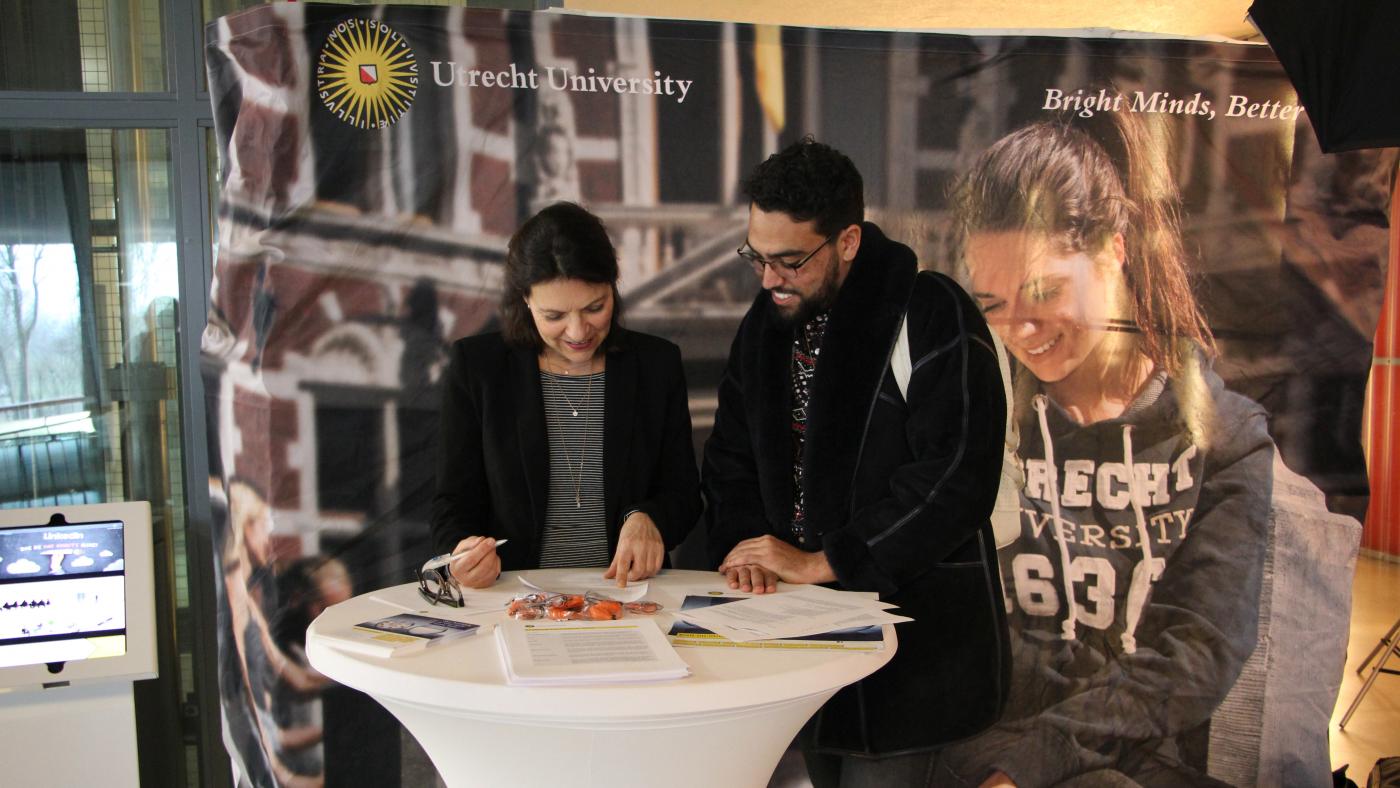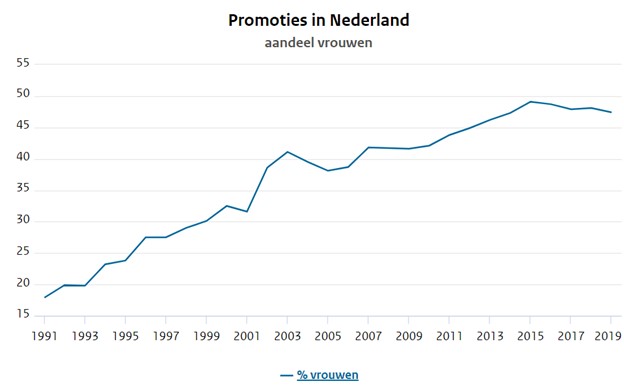Gender quota is a step backwards for individual freedom

Last week, our party, with 2 of the 24 seats on the University Council, was the only one to refrain from supporting a memo. This memo wants to introduce a Gender Quota at Utrecht University. In this essay, we want to indicate why we think that the introduction of a gender quota is not a good idea and will open the debate to the entire University.
The goal: Parity or equality?
"By 2030, 40 percent of scientific personnel, within each job category, should be women. This is an extension of the current targets in two ways: 1) the figures will become binding, and 2) the figures will be extended to all scientific personnel job categories" (memo Gender Quota).
This is how the conclusion of the memo starts. Furthermore, the University Council proposes that one third of the board members must be female. If no woman can be found for a position on the board, the seat should be left empty and not occupied by a man. Any faculty that does not achieve this quota would be sanctioned [memo Gender Quota, pp 7-8].
A required percentage of men and women at each faculty within the University is presented as:
"A nice starting point to work on [Sustainable Development Goal (DOD)] 5: 'Gender Equality', and [DOD] 10: 'Less Inequality'." (memo Gender Quota).
However, Objective 5 does not advocate parity, or sameness, but equality, and equal treatment for men and women. Sustainable Development Goal 10 is about fighting injustice in a much broader context.
The difference between parity and equality is not addressed in the proposal. It talks about achieving a required percentage of men and women in each faculty. This goes against the idea of equal treatment. This means that not every person is equal and has the same wishes, but that every person should be given an equal opportunity.
Individual interests and the role of prejudice
As an argument for women's quotas it is presented that women do not have the same opportunities to plan their careers or studies as men do right now. The lack of female professors and administrators is only explained by the argument that most people have subconscious prejudices against women in the professional world. Although sexism and prejudice certainly exist and are still present in our society, the methods to measure and prove this 'subconscious bias’ are controversial [4]. Since the test methods for "subconscious bias" do not yield reliable results, it is more productive to focus on improving communication and relationships between individuals.
This leads to the question whether sexism and bias are the only reasons why women apply less for certain jobs. Socio-psychological studies, investigating the choices and personality types of men and women in our world, show that there are more similarities between men and women, but that at the same time there are many differences in the preference for a profession between men and women. These differences even increase when men and women are raised more gender neutral, according to cited research [5,6]. The University Council’s memo indicates that even when efforts have been made to recruit gender-neutrally for positions, few or no women have shown any interest.
“The Geosciences Policy Plan shows that some departments have indicated that in recent years, on some recruitments, despite the gender-neutral text, (almost) no women responded". (memo Gender Quota)
A quota is not necessarily going to increase the interest of women in all sectors. When the interests of individuals are fairly established and are considered pivotal, it should be possible for different gender relations to exist. It is also difficult to determine at any given time how many men and women are interested in a particular study or job. This shows that the problem needs to be addressed in a different way, possibly on an individual basis. In this way, the focus is not on parity but on equality. Setting a quota ensures that many individuals do not get a fair chance to get their own preferred study or job.
Now, it is indeed important that the interests of individuals are fairly established. The memo suggests that a quota is a necessary solution for a culture change.
"But, as it turns out, a culture change doesn't happen by itself. That's why a gender quota is a necessary tool." (memo Gender Quota)
This approach is seen as a solution to discriminatory application procedures and as a mechanism that will increase accessibility in education. This suggests that the culture of work and place of study inherently do not allow women to achieve better positions and that we can only solve this problem if we force a representation. But what kind of culture yields a quota? Does it actually guarantee meritocratic access to jobs and studies? What alternatives do we have?

Meritocracy as a starting point
To answer the first question, it is important to understand the position of meritocracy in our society. Meritocracy is the foundation of a society in which every human being is approached honestly and without prejudice. A meritocratic culture exists in a society in which each person is given the opportunity to climb the social ladder based on his or her own merits. [7] Value is assigned to a person on the basis of what he or she achieves - his or her effort, talents, skills, and dedication - rather than his or her population group (such as sex, gender, or ethnicity).
In a pluralistic society, we disapprove of treating individuals better or worse based on inherent characteristics and instead focus on personal performance.
Meritocracy is the ideal we strive for as a social democratic liberal society. It is a difficult ideal to maintain and it can certainly be better implemented in various areas. At first sight, the thinking behind the quota seems altruistic with the intention of addressing the failure of meritocratic systems. However, it creates a number of new issues.
A quota appoints us - women and minorities - as victims, and tries to solve this by introducing a system in which the norms and values that it holds so dear are lost. Quotas achieve the opposite of meritocracy: they ensure selection for positions based on immutable characteristics, instead of one's own merit or right.
We are placed on a pedestal as women by quotas, while at the same time they belittle our skills. On the one hand they communicate to us that we are allowed to use our potential, on the other hand that same potential is not considered sufficient to achieve our goals. Thanks to quotas, we may be able to get the positions we really want, but we never know if we really deserve these positions or if it is only because of our gender.
By discriminating against others, quotas may be able to benefit us, but that does not alter the fact that it will remain discrimination. Fighting fire with fire cannot be the solution. The end never justifies the means, when the means changes the goal to be achieved.
Intersectionality and capabilities
Introducing quotas changes society and especially the freedom people feel. [8] For a long time, Martha Nussbaum's capabilities approach has been cited as a leading approach to achieving equal rights for all people. [9] This approach puts liberties at the centre, states that all people should be approached fairly, and is incompatible with the use of quotas. This is partly due to a problem that we show by means of intersectionality.
Intersectionality is a theoretical framework that shows in particular how belonging to several different groups leads to a complex identity. The intersection of these identities influences choices and opportunities in life, and how one is treated by others. The intersectionality emphasises the inherent problem of gender quotas:
Gender quotas increase inequality by labelling one marginalised group by a quota. This way of looking at it is disadvantageous for people who, because of one characteristic, do not belong to the marginalised group, but for other characteristics do belong to another marginalised group. All men who do belong to a marginalised group, but who are obviously not women, are thus further disadvantaged by the introduction of a gender quota. For example, a man who has a poor socio-economic background and/or is black will acquire an even worse position than before the introduction of the quota. For example, in a selection procedure this man will not be chosen if his opposing candidate is a woman, even if she is not more suitable. When intersectionality is taken into account, a quota should not only be introduced for one marginalised group, but for all. This causes two problems: not all marginalised groups are known. In addition, it is not desirable, because individual liberties are not taken into account. [9]

Position of women
Quotas can be a source of segregation and social polarisation. Even without quotas, you sometimes hear the question from boys and men: 'and who stands up for my rights'. Whereas feminism used to be a necessity and an honest quest for equality, nowadays it does not always evoke the same sentiments [11,12]. Do we want to turn our University into a playing field where one group has to compete against another group? What if we were selected without a label based on our own knowledge and ability, for our own skills, work ethic and motivation.
A few studies report on the proper functioning of quotas: after all, if you let 40 percent be women because of a quota, then there will indeed be 40 percent women. The question is not "do we also want women in top positions and equal treatment", but rather "do we want women in top positions at the expense of equal treatment or do we want women in top positions with equal treatment".
What does the introduction of quotas do with the position of women? Research shows that in some cases where women were put on electoral lists using quotas, those same women still won fewer votes than men for years.[13] Also, an unsuitable woman in the wrong place can reinforce a negative stereotype towards women instead of improving it. This shows that we cannot assume that quotas will improve the position of women in our society.
Alternative approach: Changed composition without quotas
Especially in the academic world, the memo assumes that in the Netherlands the position of women cannot be strong enough because there are not many female professors and faculty deans yet. Nevertheless, this composition may seem logical when a large proportion of the applicants were male in the past. After all, this drastically increases the chance that a man would be the best applicant in this group. A change in the composition of the professors is closely related to the composition of the academic community. Given that the composition of the academic community has changed enormously over the past thirty years, the chance that the best applicant will very soon be a woman increases as well. Whereas in 1991 only 17 percent of female PhD candidates were women, this number has been around 50 percent since 2015, and this without setting a gender quota for PhD candidates.[14]
 (Statistics: Ministry of Education, Culture and Science, 2015)
(Statistics: Ministry of Education, Culture and Science, 2015)
The memo indicates that women encounter more barriers than men in academia. That is why it is important to have fair selection procedures. Then, when women are suitable, they would be more likely to qualify for a position and environment that suits them with the respect they deserve. Applying anonymously, for example, could help with this, in combination with taking a critical look at selection procedures and providing information about job and future prospects. ‘What are you capable of? What do you want, and do you have the skills and freedom to achieve this?' are the kind of questions that should influence our professional development. Success must be independent of gender, but the process by which we implement this equality of opportunity must be fair so that we can really achieve a positive long-term sustainable effect.
The selection committee
The memo proposes the establishment of a quota committee. Instead, we propose that the budget be used for a selection committee that deals with diversity of thought, the development and implementation of fair application procedures, and the promotion of equality of opportunity based on individual skills in order to sustainably introduce equality into the work and study culture. This approach enables us to change the distribution of men and women, as well as other discrimination, within faculties and in other groups in an organic way. In this way, we can address unfair selection practices where they arise.
Unfair practices
Our focus should be on creating an open environment in which it is clear that everyone is equal, treated fairly, and respected. We need to ask ourselves what kind of representation and diversity we are striving for. Charities can lead to unfair practices. For us, quotas are one of those issues in which the goals cannot justify the means and for which we in the Netherlands, from a different angle, already find a better solution.
Works Cited:
- Ashley Driel, en Lieke Schrijvers. ‘20.087 UR Nota Genderquotum’, z.d, 2020.
- "Gender Equality And Women's Empowerment". 2020. United Nations Sustainable Development. [https://www.un.org/sustainabledevelopment/gender-equality/]
- Walter, Elizabeth, 2008, Cambridge Advanced Learner's Dictionary. 3rd ed., Cambridge: Cambridge University Press.
- Blanton, Hart and Mellers, Barbara A. et al, Strong Claims and Weak Evidence: Reassessing the Predictive Validity of the IAT, Journal of Applied Psychology, June 2009; <DOI: 10.1037/a0014665>.
- Rong Su, James and Rounds, Patrick Ian Armstrong, Men and Things, Women and People: A Meta-analysis of Sex Differences in Interests, Psychological Bulletin, 2009; American Psychological Association, Vol. 135, No. 6, 859 – 8840033-2909/09/$12.00 ,<DOI: 10.1037/a001736>.
- Lippa, Richard A., Gender Differences in Personality and Interests: When, Where, and Why?, Social and Personality Psychology Compass, 2010; Blackwell Publishing Ltd, No. 4, 1098-1110, <DOI: 10.1111/j.1751-9004.2010.00320.x>.
- ‘Definition of MERITOCRACY’, [https://www.merriam-webster.com/dictionary/meritocracy]; Geraadpleegd: 29-5-2020, 14:39:07.
- Ahsan alias Sarang, Aitzaz, Nicolas Aubert, en Xavier Hollandts, Board Gender Diversity and the Cost of Equity: From Tokenism to Critical Mass (zp juni 2019).
- ‘About Human Development | Human Development Reports’; Geraadpleegd 4 juni 2020, [http://hdr.undp.org/en/humandev].
- ‘Creating Capabilities: The Human Development Approach and Its Implementation - NUSSBAUM - 2009 - Hypatia - Wiley Online Library’, Geraadpleegd 7 februari 2020. [https://onlinelibrary-wiley-com.proxy.library.uu.nl/doi/epdf/10.1111/j.1527-2001.2009.01053.x].
- ‘Hoe de vrouw ineens de vijand werd’, RTL Nieuws (zp 2019), Geraadpleegd: 29-05-2020, 16:36:45 [https://www.rtlnieuws.nl/lifestyle/mensen/artikel/4737536/fora-mannen-klaagzang-vrouwen-vijand] .
- ‘From Feminism to the Red Pill | The Mantle’, Geraadpleegd 4 juni 2020. [https://www.themantle.com/international-affairs/feminism-red-pill].
- Bram Wauters, Bart Maddens en Gert-Jan Put, ‘It Takes Time: The Long-Term Effects of Gender Quota’, Representation 50 (2014) 143–159 <doi:10.1080/00344893.2013.860911>.
- Cultuur en Wetenschap Ministerie van Onderwijs, ‘Gepromoveerden in Nederland - OCW in cijfers’ (zp 2015) [https://www.ocwincijfers.nl/wetenschap/universitair-onderzoek/promoties-nederland].